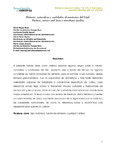
Please use this identifier to cite or link to this item:
http://ricaxcan.uaz.edu.mx/jspui/handle/20.500.11845/268Full metadata record
| DC Field | Value | Language |
|---|---|---|
| dc.contributor | 120243 | - |
| dc.contributor | 170448 | - |
| dc.contributor.other | https://orcid.org/0000-0001-5371-6676 | - |
| dc.coverage.spatial | Global | es_ES |
| dc.creator | Pérez Veyna, Oscar | - |
| dc.creator | Reyes Rivas, Elivier | - |
| dc.creator | Padilla Bernal, Luz Evelia | - |
| dc.creator | López Jáquez, Pedro | - |
| dc.date.accessioned | 2017-05-29T22:43:28Z | - |
| dc.date.available | 2017-05-29T22:43:28Z | - |
| dc.date.issued | 2008-09 | - |
| dc.identifier | nfo:eu-repo/semantics/publishedVersion | - |
| dc.identifier.issn | 1870–8196 | es_ES |
| dc.identifier.uri | http://hdl.handle.net/20.500.11845/268 | - |
| dc.identifier.uri | https://doi.org/10.48779/2mcd-6j87 | - |
| dc.description | This work has as objective to show features about the history, nature and importance of the bean, product that was able to become primordial source of food for the man, who could tame from before Columbus times through the time and later to develop varieties able to adapt to specific conditions of cultivation, whose relevance even ends up transcending cultural and traditional bonds of production and consumption, like it is the case of the Latin American continent where bigger acceptance exists. When revising the literature, historical data and complementary sources, it is determined a strong association of the leguminous one with the tradition, nutritional qualities and social and economic relevance for who cultivate it. | es_ES |
| dc.description.abstract | El presente trabajo tiene como objetivo exponer algunos rasgos sobre la historia, naturaleza y cualidades del fríjol, producto que a través del tiempo ha logrado convertirse en fuente primordial de alimento para el hombre. El ser humano, desde tiempos precolombinos, tuvo la capacidad de domesticar y más tarde desarrollar variedades capaces de adaptarse a condiciones específicas de cultivo, cuya relevancia actual llega incluso a trascender vínculos culturales y tradicionales de producción y de consumo, tal es el caso del continente latinoamericano donde tiene mayor aceptación. Al llevar a cabo una revisión de literatura, datos históricos y fuentes complementarias, se ubica una fuerte asociación de la leguminosa con la tradición, las cualidades nutricionales, así como la relevancia social y económica que representa para quienes lo cultivan. | es_ES |
| dc.language.iso | spa | es_ES |
| dc.publisher | Universidad Autónoma de Zacatecas | es_ES |
| dc.relation | http://www.estudiosdeldesarrollo.mx/administracion/docentes/documentos_personales/15599InvestigacionCientificaVol4No3_1.pdf | es_ES |
| dc.relation.uri | generalPublic | es_ES |
| dc.rights | openAccess | es_ES |
| dc.rights.uri | http://creativecommons.org/licenses/by-nc-sa/3.0/us/ | * |
| dc.source | Revista Investigación Científica, Vol. 4, No. 3, Nueva época, septiembre–diciembre 2008 | es_ES |
| dc.subject.classification | CULTIVOS DE CAMPO [3] | es_ES |
| dc.subject.other | info:eu-repo/classification/Frijol - Nutrientes | - |
| dc.subject.other | info:eu-repo/classification/Botánica | - |
| dc.subject.other | info:eu-repo/classification/Beans | - |
| dc.title | Historia, naturaleza y cualidades alimentarias del fríjol | es_ES |
| dc.title.alternative | History, nature and bean’s nutritious quality | es_ES |
| dc.type | info:eu-repo/semantics/article | es_ES |
| Appears in Collections: | *Documentos Académicos*-- UA Estudios del Desarrollo | |
Files in This Item:
| File | Description | Size | Format | |
|---|---|---|---|---|
| Perez Oscar. Historia.pdf | Versión publicada | 244,31 kB | Adobe PDF |  View/Open |
This item is licensed under a Creative Commons License
